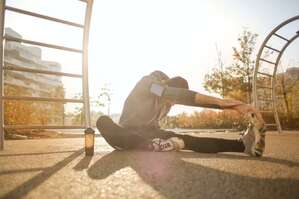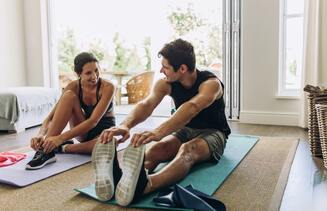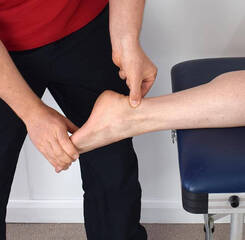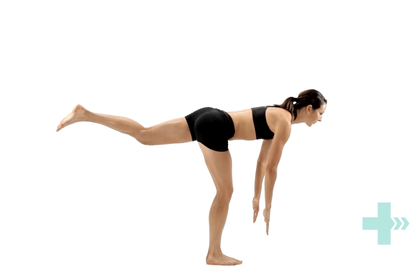|
Being active is one the most important aspects of a healthy lifestyle and there are many different ways to get your heart rate up. No matter what your choice of activity is, there is always some risk of injury. In this article, we have listed some tips to help you prevent accidents and injuries. 1. Choose the right footwear
The correct footwear can go a long way in protecting your feet and ankles from injury and can even prevent serious accidents such as falls. Every activity places different demands on your body and tailoring your footwear to suit these stressors is a great strategy for preventing injuries. For example, basketball players often wear shoes with support that extends above the ankles to help protect against ankle sprains, while hikers require thick and supportive soles to cushion and protect their feet. Wearing shoes that are too large or have poor grip can lead to slips and falls, particularly when exercising in the outdoors. Your physiotherapist can guide you with the correct choice of footwear for your chosen activity. 2. Pace yourself When you start to see improvements in your fitness and strength, it can be tempting to push your limits to see just how far you can go. The danger in this is that often your tissues are still adapting to the increased demands of your new exercise regime. Increasing your weights, training time or running distances by too much too soon can lead to major setbacks. Give your body time to adjust and progress in a slow and steady manner. 3. Check your form and posture Checking your posture in the middle of a workout is probably the last thing on your mind, however poor form is a leading cause of injury in athletes. As an example, lifting weights when your spine is not in its optimal position causes many low back injuries. Taking a second to check your posture before starting a lift is highly recommended. 4. Seek professional advice Coaches and trainers are able to help you spot vulnerabilities and share their knowledge, helping you get the most out of your chosen activity. Often it is easier to prevent bad habits from forming than it is to break them once they are already in place. Invest in the advice of an expert, they can help you to avoid injuries as well as reach your peak performance. Your physiotherapist is able to identify weakness in your training technique, biomechanical vulnerabilities, tight and/or weak muscles and can help guide you through your recovery if an injury does occur. However, prevention of injuries is always preferable to treatment whenever possible.
0 Comments
There’s no doubt that doing the right thing for your health can be difficult. Whether that involves eating healthier, exercising more, flossing your teeth or even doing your physio exercises, the best choice is not always the most comfortable. Once a habit has formed and become part of your routine, making the right decision for yourself can become a lot more straightforward. Getting to that point is easier said than done. Here are a few tips to help you reach your health goals...
1. Choose a friend to join you for accountability. One way to guarantee that you show up for an early morning gym session is to have a friend who you partner with. You might be comfortable sleeping in for yourself, but not so much when you have someone else you’re letting down. Sharing difficult tasks with a friend can make them more enjoyable and you can also set up competitions with them if you need a little extra motivation. 2. Combine tasks with an activity that you do like. Love a true crime podcast? The gym can be the time to catch the latest episode or even stream your favourite show. Anything you do that helps to increase the enjoyment of the activity you’re avoiding is going to help you get started. 3. Batch tasks to be more efficient. Are you trying to drink more water, floss and also complete your physio exercises? Why not do all three in the same sitting? Combining tasks can be a surprisingly effective use of time and a way to remind yourself to complete them. 3. Use positive reinforcement for good behaviour, rather than punishments. Many people will feel bad when they fail to reach their goals and try to restrict themselves in another area to compensate. It can be a much more effective motivation strategy to reward yourself after completing a task, rather than punish yourself for not doing it. 4. Get your foot in the door. Putting your shoes on can be the hardest part of going for a run. If you’re struggling to complete a task, sometimes all you have to do is tell yourself you only need to do five minutes. Once you’ve started quite often you’ll want to do more, but setting small goals can be the trick to getting started. Once a habit is in place, the easy part is to increase the intensity or length of time you’re doing it. It's believed that it takes 21 days of completing a task for a habit to be formed, where you will then do it automatically as part of your routine. For more tips and tricks on how to reach your health goals, speak to your physiotherapist. While there are many benefits to be gained from effective stretching, employing an improper technique can actually result in injury. Here are some tips and guidelines for you to follow when stretching... - Warm up first with an activity such as walking (at least 5 -10 minutes).
- Stretches should be pain-free. You should only feel tension or a tight feeling when stretching. If you feel a sharp pain, this means you're stretching too far. - Don't hold your breath while stretching, keep breathing to ensure the muscle tissues remain oxygenated during the stretch. - Stretch both sides. But if one muscle is tighter than the other, focus on it more until they're both in the same range. - Avoid bouncing at the end of the stretch because it may lead to injury. - Hold stretches for 20-30 seconds, if not longer. A 10 second stretch is not always enough to achieve a lasting effect. - Repeat the stretch 3-5 times with intermittent rest periods in between. - Make sure your body is aligned properly and observe good posture. When to Stretch? Traditionally, stretching has been encouraged before and after any kind of physical activity. However, recent studies show that there is no discerning difference between whether you stretch before exercise/sports or not, both in terms of performance and injury prevention. In some cases, researchers say that it's okay to omit the pre-event stretch since the post-event stretch is much more beneficial. Some of our everyday postures and activities can lead to certain muscles becoming tight while the others sit in a lengthened position. These habitual postures that lead to muscle imbalances then become more and more difficult to correct over time. Many therapists will suggest that stretching all muscles generically isn’t as beneficial as identifying which of your muscles are abnormally tight and developing a targeted stretching regime. Talk to your physiotherapist for advice regarding the best stretching program for your body type, posture and activity levels. We know many of the habits that shape our adult lives are set in childhood. Physical activity is important for a growing body as movement and weight bearing have a large impact on bone strength, muscle and tendon health. Here are some tips to make sure your child is staying as active as possible. 1. Find an activity that suits your child.
Children who are coordinated and excel in competition may find team sports both increase their self-esteem as well as keep them fit. For other children, being a part of a team can be uncomfortable. Less competitive children may prefer a sport where success is measured by improving on their own performance, rather than being compared to other children. Surfing, yoga, martial arts, dancing or gymnastics may be activities that suit your child if competitive and team sports cause them to be discouraged. 2. Do get injuries checked out by a professional and invest in proper rehabilitation. While children do bounce back quickly from injuries, they also may have difficulty expressing pain and discomfort. A niggling pain that won’t go away may cause your child to say “I don’t like sport” rather than realising that they are in pain. Some children may retain worries that they will hurt themselves again because of a previous injury and avoid exercise. Your physiotherapist can help to identify any issues that your child is having and help to resolve them. 3. Set fun and challenging goals for them to complete during their daily routine. As less children are walking and riding to school, try to find ways to fit extra activities into the day. Some fun examples include running a daily long jump competition in the back yard or adding a routine of age appropriate exercises, such as star jumps, hopping, balancing and running on the spot. You can make these exercises part of the night or morning ritual, just like brushing your teeth. There are many reasons to choose a form of cycling as a sport. Commuting to work by bike can help you conveniently find time for exercise, save money on transport costs and is a great way to exercise if you need to avoid excessive weightbearing. Biking injuries are quite common, but in many cases preventable. Here are a few tips from us to help you prevent cycling injuries and improve your performance. Don't neglect your upper body strength and trunk stability.
While cycling is a sport that predominantly uses the legs, it's a mistake to think that leg strength is the only thing that matters when it comes to biking performance. Increasing the strength, flexibility and balance of your upper body and trunk can actually reduce the amount of effort used to cycle and improve the efficiency of your pedalling. Focusing on your whole body fitness can both improve your riding performance and help to prevent the neck, back and shoulder pain that can come as a result of maintaining postures for extended periods. Yoga and Pilates are great complementary activities to help build upper body strength and stability while also counteracting the effects of prolonged flexed postures of the bike. Don't skimp on your helmet. A good quality helmet can mean the difference between a sore head and a life-changing injury. Helmets become less effective with each hit, as they can lose their shock-absorbing capacity even if they don't appear to be damaged. If in doubt after a crash, make sure you replace your helmet as it may help to save your life. Address aches and pains early. Due to the repetitive nature of cycling, overuse injuries are common. Ensuring your bike is set up correctly to minimise stress on your body while riding and paying attention to small niggles before they become bigger problems can help to identify and resolve issues early so that you can keep cycling without discomfort. Speak to your physiotherapist for more information on how to improve your performance and stay injury-free while biking. Many people know the value that physiotherapy brings to their life and some have even been visiting their physiotherapist since quite early in life. However, for those who have never been to see a physiotherapist before, there can be a question mark over exactly what it is that physiotherapists do. In fact, this is one of the most common questions we as physiotherapists are asked. What is the main job of a physiotherapist?
The answer is tricky, because physiotherapists do so much. Primarily, we might be described as pain management experts, as we work to reduce the pain of our patients, from those who have suffered a new injury, to those who have had pain for several years. We first identify the cause of the pain and then provide manual therapy techniques, education and management strategies to help our patient understand, manage and reduce their pain. While pain is usually the first thing that brings patients to see a physiotherapist, this pain has often caused patients to give up activities that they love and can even be getting in the way of everyday tasks. Many of us reduce our activity levels to reduce pain without even realising it. Physiotherapists are able to identify which areas you are struggling in and why this is occurring. By identifying the cause of your symptoms, we can help to get you back to full function. Physiotherapists are able to do this for everyone including elite athletes and those dealing with serious disabilities. In fact, physiotherapists have a role to play at practically every stage of life. Specialised paediatric physiotherapists can assess infants to monitor their motor skills development and as they grow we help them deal with the pains and vulnerabilities of a growing body. Among other things, we can help improve the function of athletes, assist in preventing injuries, help those with pelvic floor dysfunction and work to prevent falls in the elderly. Not just exercises and massage. Physiotherapists offer a range of treatments, from targeted stretches and strengthening exercises, manual therapies, dry needling, lots of advice on activity modification and massage. Physiotherapists are also committed educators and take our role as such seriously. A huge part of recovering from pain and injury comes from understanding what is happening and how to best manage these issues. Rather than create a dependency on their therapist, we aim to empower our patients to improve their health independently as much as possible. Physiotherapists aim to improve your quality of life and remove any barriers to full participation, whether these barriers are due to pain, weakness or stiffness. Seeing a physiotherapist is an important investment in your health and recovery from pain or injury. Here are a few tips to help get the best outcomes from your treatment sessions... 1. Know what your goals are and ask questions.
If you are clear on what you hope to achieve through physiotherapy, this can help you and your therapist to work together to direct treatment towards these goals. Understanding your condition also plays an important part in recovery, it means that you can make better choices to protect your body and and allow it to heal, and you will know better how to prevent future injuries. Before each treatment, it can help to take a few moments mentally to prepare some questions and consider what your short and long-term goals might be. 2. Do your exercises. Targeted home exercises are almost always an essential part of your recovery as they help your body to support itself through healing and recovery. Exercising is an important way to help correct biomechanical imbalances and reduce excess stress on body structures, as well as helping tissues to strengthen as they recover. 3. Follow your therapist's recommendations. Throughout your recovery, your therapist will guide you as to which activities you should avoid and how much rest to take. Return to sport and activity should be gradual, so as not to stress the body too much too soon when it is still healing. Rest is just as important a part of recovery as strengthening. Following the advice given by your therapist can ensure that you don't injure yourself again and that you get the most out of your body. 4. Be patient with your progress. It can be frustrating waiting for your body to heal. Returning to sport too early or giving up on treatment are common mistakes that lead to further injury or impaired healing. Recovery takes time, a general rule is often that the longer a condition has been present, the longer it will take to resolve. If there is a part of your condition or injury that you are struggling to understand, be sure to seek clarification with your physiotherapist. Two-way communication is key. Many people already know the value that physiotherapy brings to their life, they may have had a physiotherapist with them through the highs and lows of injury and recovery more than once! However, for those who have never been to see a physiotherapist before, there can be a question mark over exactly what it is that physiotherapists do. What is it that physiotherapists do?
The answer is tricky because physiotherapists do so much. We might be described as pain management experts, as we work to reduce the pain of our clients, from those who have suffered a new injury to those who have had pain for several years. We first identify the cause of the pain and then provide manual therapy techniques, education, exercise and self-management strategies to help our patients understand, manage and reduce their symptoms. The pain or injury that motivates people to come and see us has often made them give up activities or sports that they love and can even be getting in the way of everyday tasks. By identifying the cause of your symptoms, we can help to get you back to full function. Physiotherapists are able to do this for people at all activity levels, including the general public, elite athletes and those dealing with serious disabilities. In fact, physiotherapists have a role to play at practically every stage of life. We can assess infants to monitor their motor skills development and as they grow we help them deal with the pains and vulnerabilities of a growing body. Among other things, we can help to prevent injuries, improve pelvic floor dysfunction and work to prevent falls in the elderly. Not just exercises and massage. Physiotherapists offer a range of treatments, from self-management strategies, stretches, manual therapies, dry needling, exercises and massage, to name a few. A huge part of recovering from pain and injury comes from understanding what is happening to you and how to best manage your issues. Rather than create a dependency on your therapist, we aim to empower our patients to improve their health independently as much as possible as well. A physiotherapist's primary goal is to improve your quality of life and remove any barriers to full function and participation in whatever you desire, whether these barriers are due to pain, weakness or stiffness. The benefits of keeping active may seem obvious, yet it can't hurt to be reminded of the many ways exercise can improve your life. Here are a few of our favourite reasons to get moving... 1. Exercise improves energy levels.
Improving your fitness means your body is capable of achieving more for the same energy expenditure. While doing exercise can make you tired in the short term, regular improvements to your fitness will help you get more out of your body each day, with seemingly less effort. 2. Exercise can help to reduce stress. If you are stuck in a state of stress or anxiety, exercise can help you move out of it into a calmer and more relaxed state, improving your mood, concentration and sleep. There are now many studies to support this. 3. Exercise and hobbies can help you build connections and community. Making new friends as an adult can be surprisingly difficult and the importance of connection and community is being recognised more and more as being essential for overall wellbeing. Being part of a team, group or club is a great way to build confidence and meet friends as well as keeping active. 4. Exercise keeps your muscles, tendons, joints and bones healthy. Our bodies are often compared to machinery or car parts. However, there are some crucial differences between our bodies and machines, including the fact that our bodies respond to exercise by becoming stronger and healthier, rather than being worn out. As an example, one of the best ways to prevent osteoporosis is through regular high impact activity, which stimulates bone growth. 5. Exercise can help to reduce injuries. Similar to the previous point, tissues that are used regularly are stronger, more elastic and are less likely to tear or break when under stress. Regular exercise is the best way to keep your body in a healthy state and prevent injuries. Finding the right exercise for you can be tricky, your physiotherapist can help you with suggestions based on your ability and skillset if you need some help. Your physiotherapist has a wide variety of skills and can help you with so much more than just pain and injury. Here are a few reasons to visit your physiotherapist that can keep you healthy and pain-free, before injury strikes... Stiffness and Inflexibility
Almost all of us have experienced pain and stiffness after a day of increased or unaccustomed exercise. This kind of stiffness usually wears off quickly and is referred to as DOMS (delayed onset muscles soreness). However, if you find yourself feeling stiff for more extended periods, or even most of the time – it might be time to see a physio. There are many different causes of stiffness and inflexibility. By far the most common is lack of movement. Our joints and muscles both lose flexibility if not moved through their range regularly. Muscle stiffness can feel like a tightness with a bouncy feeling of restriction, and joint stiffness can create a harder ‘blocked’ feeling when you try to move. When it comes to stiffness that evolves from lack of movement, you may not even notice that you have lost range, as it can be easy to adapt your movements to compensate. Your physiotherapist can help you to identify where you have areas of inflexibility and help you to exercise, stretch and mobilise your joints to get them back to a healthy range. Disease processes such as osteoarthritis and rheumatoid arthritis can also cause prolonged stiffness, and your physiotherapist is well equipped to help you deal with these conditions. Reduced Strength or Weakness There are many possible reasons for weakness in the body, from generalised disuse, weakness in one muscle group following an injury, neurological weakness or structural weakness of joint following a ligament tear. Musculoskeletal deficiency of any kind can predispose you to future injuries and are difficult to resolve without targeted exercises. Your physio can determine the cause of your weakness and prescibe the best treatment to restore your strength. Reduced Balance Keeping your balance is a complicated process and your body works hard to make sure you stay on your feet. Humans have a small base of support for our height and we use all our senses together to determine which movements we should make to stay upright, including our visual, vestibular, muscular and sensory systems. As balance is essential for walking, if one system that supports our balance begins to weaken, the others will quickly compensate, so you may not notice that your balance has worsened until you fall or trip over unexpectedly. As a general rule balance deteriorates as we get older, but this doesn't mean that falling should be an inevitable part of aging. Actively working to maintain or improve your balance can have a significant effect on your quality of life and confidence in getting around. Your physiotherapist is able to test all aspects of your balance and provide effective rehabilitation to help keep you on your feet. |
Categories
All
|











